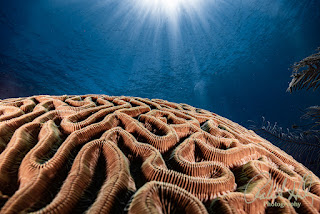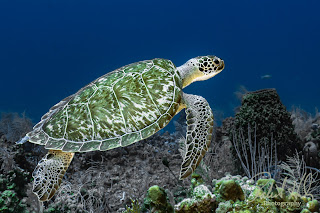Editing Diver Portraits in Lightroom Classic & Lightroom
Making Skin Tones Look Natural Underwater
One of the most common frustrations for underwater photographers is encountering a situation where, upon reviewing their shots, they notice that their dive buddy's skin has taken on an unnatural hue, ranging from shades of blue to green or even purple. While it's true that fish and coral often respond well to global color adjustments, human skin tones in underwater photos require more targeted and intelligent corrections to appear natural and lifelike.
The good news is that modern editing software has made this task much easier. Both Lightroom Classic (v14.5.1) and Lightroom (cloud-based v8.5.1) now come equipped with powerful AI-driven features, including AI-powered masks, Point Color, and luminance controls. These tools allow you to restore natural skin tones quickly, accurately, and with minimal fuss. Whether you prefer the comprehensive, desktop-based Lightroom Classic or the sleek, cloud-based Lightroom, the tools are nearly identical in capability. Additionally, they synchronize seamlessly across your devices, allowing you to work smoothly from anywhere.
To help you make the most of these new features, I've put together a detailed, step-by-step workflow for editing diver portraits. The guide includes side-by-side instructions tailored to each platform, so you can follow along easily whether you're using Lightroom Classic or Lightroom. With these tips, achieving natural, vibrant skin tones in your underwater photos becomes faster, simpler, and more reliable, allowing you to focus on capturing stunning images beneath the waves.
Why Diver Skin Looks "Alien" Underwater
Light behaves quite differently underwater compared to what we're used to on land. One of the notable changes is how quickly specific colors, especially reds, disappear or become less visible; they typically fade away within just 5 to 10 meters (or about 15 to 30 feet) of depth. This loss of red and other warm colors leaves your underwater subjects mainly illuminated by blue and green light, which can sometimes make images look a bit cooler or more monochromatic.
Additionally, when you introduce mixed artificial lighting or experience backscatter, those tiny particles that reflect light back to your camera, the scene can look even more surreal or alien, often making your dive buddy appear more like an extraterrestrial than a friend. To correct these color shifts and improve your underwater photos, simply adjusting the White Balance isn't enough. Instead, you need to apply local corrections, targeted adjustments to specific areas of your photo. That's where modern editing tools, such as Lightroom's AI-powered features, come into play.
With tools such as Select People, Point Color, and Luminance Range, you can make precise adjustments to recreate the natural appearance of colors at different depths, aiding in the production of clear, vibrant, and true-to-life images from your underwater adventures.
Step-by-Step Workflow
Step 1. Correct Exposure & White Balance
In Lightroom Classic (LrC):
-
Go to the Develop module > Basic panel.
-
Adjust the Exposure until the diver's face is lit correctly.
-
Press
W,to activate the White Balance Selector, click a neutral area on the diver's gear, then fine-tune:-
Temp around 5200–6000K
-
Tint toward magenta (+5 to +10)
-
In Lightroom (cloud):
-
Go to Edit panel > Light.
-
Adjust Exposure and Contrast sliders.
-
White Balance can be set to Auto or adjusted manually using the eyedropper.
Step 2. Isolate the Diver with People AI Mask
In LrC:
-
Open the Masking panel > People (
Shift + W). -
Select 'Face Skin' (and 'Lips' if needed).
-
Adjust:
-
Temp +5–10
-
Tint +3–8 toward magenta
-
Exposure +0.2 if underlit
-
Texture -5 for smoothing
-
In Lightroom (cloud):
-
Click Masking > Select People from the right-hand toolbar.
-
The same Face Skin and Lips options appear. Adjust Temp, Tint, and Exposure in the mask properties.
Step 3. Refine Problem Areas with Point Color
In LrC:
-
Scroll to Color Mixer > Point Color (
Shift + C). -
Use the eyedropper to sample a patch of bluish or greenish skin.
-
Adjust the Hue toward reds/oranges, reduce the Saturation of odd colors, and raise the Luminance slightly.
In Lightroom (cloud):
-
Tap Color > Point Color.
-
Same workflow: select patch → refine Hue, Sat, and Lum.
💡 Tip: Use multiple samples (cheeks, forehead, lips) for the most natural look.
Step 4. Balance Skin with Luminance Range
In LrC:
-
Create a New Mask > Luminance Range.
-
Eyedropper on the face midtones.
-
Refine sliders to exclude background water.
-
Raise Exposure by 0.2–0.4 and Temperature warmth.
In Lightroom (cloud):
-
In Masking, choose Luminance Range.
-
Select the skin area, refine range, adjust Exposure, and Temp.
Step 5. Polish the Portrait
Clarity & Texture:
-
Apply lightly (+5 to +10) to dive gear, but avoid applying it to skin.
Noise Reduction:
-
In LrC: Go to Detail panel > Luminance NR (20–40). For RAW/DNG, click Denoise (AI) (
Ctrl/Cmd + Shift + D). -
In Lightroom: Detail > Noise Reduction slider, or use AI Denoise for RAW/DNG.
Sharpening:
-
LrC: Hold Alt/Option while dragging the Masking slider to protect skin.
-
Lightroom: Use the Sharpening slider and add Masking as needed.
Vignette:
-
LrC: Effects panel > Post-Crop Vignetting (-10).
-
Lightroom: Effects > Vignette (-10).
Real-World Examples
Example 1: Shallow Reef Portrait (RAW, Nikon Z8 + Nauticam)
-
Problem: Cyan face, reef OK.
-
Fix: People Mask (Temp +7, Tint +5). Point Color on the cheek.
-
Result: Natural warmth remains; the reef remains unchanged.
Example 2: Wreck Interior (Sony A7R V + Kraken)
-
Problem: Purple lips, blotchy shadows.
-
Fix: Luminance Range mask midtones, Exposure +0.3, Tint +6. AI Denoise 35%.
-
Result: Clean shadows, healthy lips.
Example 3: Group Shot (Canon R6 II + Sea&Sea)
-
Problem: Uneven lighting, with one diver appearing green and another reddish.
-
Fix: Separate People Masks, Point Color per diver.
-
Result: Consistent skin tones across the group.
File & Tool Compatibility Chart
| Workflow Step | Lightroom Classic v14.5.1 | Lightroom (Cloud v8.5.1) | Lightroom Mobile v10.5 | Photoshop / ACR v17.5 | Supported Formats |
|---|---|---|---|---|---|
| White Balance & Exposure | ✅ | ✅ | ✅ | ✅ | RAW, DNG, JPEG, HEIC |
| People AI Mask | ✅ | ✅ | ✅ | ✅ | RAW, DNG, JPEG, HEIC |
| Point Color Adjustments | ✅ | ✅ | ✅ | ✅ | RAW, DNG, JPEG, HEIC |
| Luminance Range Mask | ✅ | ✅ | ✅ | ✅ | RAW, DNG, JPEG, HEIC |
| AI Denoise v2.0 | ✅ (RAW/DNG best) | ✅ | ✅ (limited) | ✅ | RAW, DNG, JPEG, HEIC |
| Export / Sync | ✅ | ✅ | ✅ | ✅ | All formats |
Pro Tips for Oceanic Explorers
-
Shoot RAW/DNG whenever possible: You'll unlock full AI Denoise and better color depth.
-
Check your edits across devices: Cloud sync ensures your masks and Point Color settings remain intact between Classic, Lightroom, and Mobile.
-
Use separate People Masks for groups: Each diver's skin requires its own correction.
-
Calibrate your monitor: Subtle reds and magentas look different on uncalibrated screens.
Why This Workflow Matters
Diver portraits hold a special place in underwater photography because they create some of the most powerful and emotional connections with viewers. When skin tones appear unnatural or off, it can unfortunately diminish the authenticity and emotional impact of the image, making the memory feel incomplete or broken.
To address this, modern editing tools like Lightroom Classic and Lightroom (cloud) have incorporated advanced features that utilize AI-powered masking and precise color targeting. These innovations allow photographers to carefully restore and enhance the natural colors of their underwater subjects. This way, you can bring your images back to life exactly as you saw them underwater, with natural, true-to-life skin tones and facial features, eliminating the unwanted appearance of alien-like faces and helping your photos convey the genuine emotion and connection that make underwater portraiture so compelling.
Final Thoughts
Whether you're editing in Lightroom Classic, which offers maximum control and precision, or in Lightroom (cloud), which provides a more streamlined, cloud-synced workflow, the tools available for correcting diver skin tones have become equally powerful and versatile. The secret to achieving natural-looking results lies in applying targeted adjustments rather than relying solely on global warmth sliders. Techniques such as using the People AI Mask, Point Color, and Luminance controls enable precise, localized edits that enhance skin tones without affecting the rest of the image.
So, the next time you're working on a friend's portrait and it looks more extraterrestrial than terrestrial, perhaps due to uneven lighting or odd camera settings, remember that with just a few careful, targeted clicks, you can restore their natural, authentic look. This not only improves the photo but also helps preserve the genuine memory of the moment you captured, making your edits both effective and respectful of the subject's actual appearance.
📌 Learn more editing strategies at: info.robertherb.com/lm-2-blog
📌 Share your before & afters using #RobertHerbPhotography
📌 Weekly blogs drop at Robert Herb Photography Blog
— Bob Herb 📷
🧭 What's Next?
🟦 Have you tried any of these techniques yet? Share your edits using #RobertHerbPhotography.
🟦 Want to see these workflows in action? Sign up for my upcoming training course at RobertHerb.com or reach out at bob@robertherb.com
🟦 And don't forget—new blogs drop weekly at Robert Herb Photography Blog
Written by Robert Herb – Empowering underwater photographers to capture and enhance the beauty of our oceans since 1978
Stay tuned for more in-depth insights into underwater photography. Let's dive deeper into the art and craft of capturing the marine world! If you have any comments or suggestions, I'd love to hear them.
Get ready for an exciting underwater photography adventure! For more details on my upcoming online training course, check out my "Training" page at RobertHerb.com or email me at bob@robertherb.com.
Sincerely,
Bob Herb
|
|





Comments
Post a Comment
Please let me know your comments.